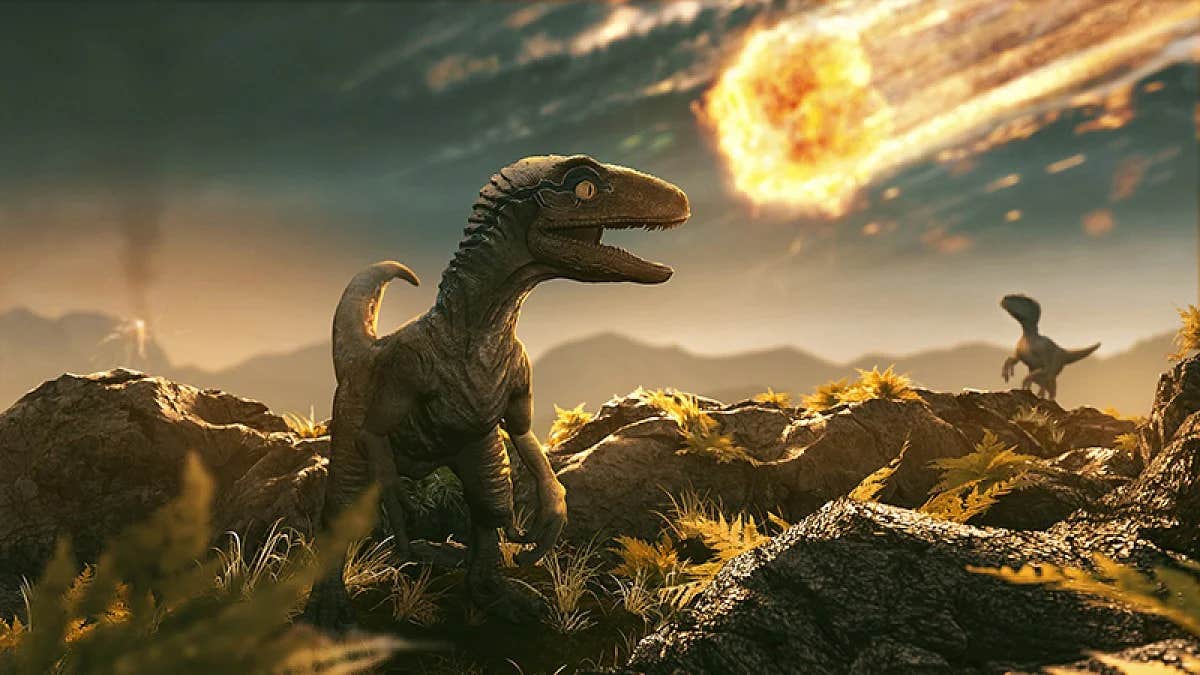Dinosaurs thrived until the end: New Mexico fossils rewrite extinction story
New Mexico fossils show dinosaurs were thriving until moments before the asteroid impact 66 million years ago.

 Edited By: Joseph Shavit
Edited By: Joseph Shavit

A new study reveals dinosaurs in New Mexico were thriving just before the asteroid impact that ended their reign, overturning long-held extinction theories. (CREDIT: Wikimedia / CC BY-SA 4.0)
Of all the mysteries surrounding dinosaurs, none has sparked more debate than how their era ended—was it a gradual decline or a sudden catastrophe? A new study led by Andrew Flynn of New Mexico State University delivers one of the clearest answers yet: dinosaurs in what is now New Mexico were thriving right up until the asteroid impact that ended their reign.
A World on the Brink
Published in the journal Science, the research focused on the Naashoibito Member of the Kirtland Formation in northwestern New Mexico’s San Juan Basin. Using advanced dating methods, Flynn’s team determined these rocks are between 66.4 and 66.0 million years old, placing the fossils within just 400,000 years of the asteroid strike that wiped out 75% of Earth’s species. That’s practically yesterday in geologic time.
The site paints a vivid picture of a flourishing ecosystem. Giant sauropods like Alamosaurus—some stretching nearly 100 feet long—roamed alongside duck-billed hadrosaurs, horned herbivores, and smaller creatures. “Dinosaurs are not on their way out going into the mass extinction,” Flynn said. “They’re doing great, they’re thriving, and the asteroid impact seems to knock them out.”
This conclusion directly challenges long-held theories that dinosaurs were already dwindling before the Chicxulub asteroid hit. Instead, the evidence shows that North America hosted dynamic, regionally distinct ecosystems until the very end of the Cretaceous.
Cracking the Rock Time Code
The San Juan Basin has intrigued scientists for more than a century, but pinning down the precise age of its fossils was tricky. Layers of rock there have been warped and eroded, making them harder to interpret than the tidy strata at the famous Hell Creek Formation in Montana and the Dakotas.
Flynn’s team spent years carefully mapping layers, collecting samples, and analyzing the magnetic properties of rocks—since Earth’s magnetic field periodically flips, these reversals serve as time stamps for ancient sediments.
By comparing volcanic sand grains using radiometric dating and analyzing magnetic orientation, the researchers determined that the Naashoibito fossils were laid down less than half a million years before the extinction. “These factors make dinosaur-bearing rocks from the last 400,000 years of the Cretaceous quite rare,” Flynn explained, noting that few teams attempt such painstaking work.
Two Worlds, One Catastrophe
When compared with the northern Hell Creek ecosystem, the Naashoibito site reveals a striking pattern. Both regions had iconic dinosaurs like Tyrannosaurus rex and Triceratops-like horned herbivores, but the southern ecosystem was warmer, wetter, and home to enormous sauropods absent in the north. “The Naashoibito Member was like a tropical forest, similar to modern Panama,” Flynn said, while the Hell Creek region was cooler and more temperate.
Steve Brusatte, a paleontologist at the University of Edinburgh, described the southern scene vividly: “One minute a jet plane-sized dinosaur was shaking the ground as it walked, the next minute the whole Earth was shaking with the energy unleashed by the asteroid.”
These climate-driven regional differences show that late Cretaceous ecosystems were still complex and varied. Dinosaurs were adapting to local environments just as they had for over 150 million years—dividing up food sources, evolving in size and shape, and filling ecological niches across the continent. “There is no sign that these dinosaurs were in any trouble,” Brusatte said.
Diversity Until the End
To understand how these ecosystems were arranged, the researchers analyzed the distribution of species across ancient North America—then known as Laramidia. Their data revealed distinct northern and southern “bioprovinces” that persisted for millions of years, shaped largely by climate rather than geography. Warm, humid southern regions favored species like Alamosaurus, while cooler northern climates supported other plant-eating dinosaurs.
The team found no signs of ecological collapse in the south. Fossils from the Naashoibito site showed diverse species and stable populations, contradicting previous ideas that dinosaurs were fading away. Instead, it seems their extinction came suddenly, not gradually. “The sum of evidence suggests that non-avian dinosaurs were abruptly struck down at the end of the Cretaceous and were not in long-term decline,” the authors wrote.
The Dawn After Darkness
The asteroid impact 66 million years ago unleashed wildfires, tsunamis, and a global “impact winter.” Yet life bounced back faster than anyone might expect. Within about 300,000 years, early mammals began to fill the empty niches left behind. These species diversified quickly in both northern and southern regions, showing that even after catastrophe, evolution moves fast when opportunity strikes.
Remarkably, the climate differences that had divided dinosaurs persisted into the Paleocene, shaping early mammal evolution just as they had influenced their predecessors. The patterns of life survived, even when the players didn’t.
Lessons From a Lost World
Independent experts agree that the study marks a major advance in understanding the final days of dinosaurs. “This new evidence about these very late-surviving dinosaurs in New Mexico is very exciting,” said Michael Benton, a vertebrate paleontologist at the University of Bristol. While he cautioned that one site can’t represent the entire world, the findings “show rich faunas where climates were favorable.”
Darla Zelenitsky of the University of Calgary added that the results align with her team’s discoveries in Alberta, where fossilized eggshells suggest stable populations right up to the end. “The research team uncovered compelling new evidence that dinosaurs were still going strong till the very end,” she said.
Practical Implications of the Research
The study’s findings don’t just rewrite dinosaur history—they also carry a warning for today. Earth’s past shows that even robust ecosystems can collapse in the face of sudden, global disruption.
Flynn’s research reminds us that stability doesn’t guarantee safety. As University of Edinburgh’s Steve Brusatte put it, “Sudden climate and environmental change can catch animals and ecosystems unaware, and can defeat even the strongest and most iconic of species.”
The story of the Naashoibito dinosaurs is one of vitality, not decline. It’s a vivid reminder that thriving life can vanish in an instant—and that understanding these ancient events helps us grasp the fragility of our own planet’s balance.
Research findings are available online in the journal Science.
Related Stories
- New evidence reveals massive earthquake linked to dinosaur extinction
- New study reveals the devastating force that drove dinosaurs to extinction
- New fossil discoveries reveal life before Earth’s greatest extinction
Like these kind of feel good stories? Get The Brighter Side of News' newsletter.
Mac Oliveau
Science & Technology Writer
Mac Oliveau is a Los Angeles–based science and technology journalist for The Brighter Side of News, an online publication focused on uplifting, transformative stories from around the globe. Passionate about spotlighting groundbreaking discoveries and innovations, Mac covers a broad spectrum of topics—from medical breakthroughs and artificial intelligence to green tech and archeology. With a talent for making complex science clear and compelling, they connect readers to the advancements shaping a brighter, more hopeful future.



